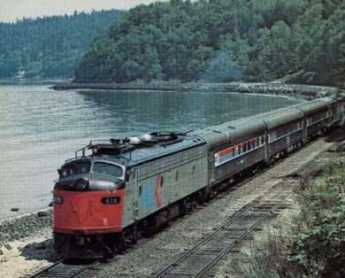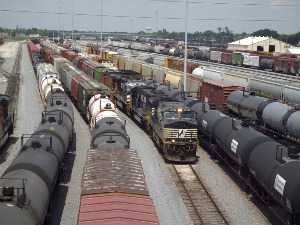Related Topics
Franklin Inn Club
Hidden in a back alley near the theaters, this little club is the center of the City's literary circle. It enjoys outstanding food in surroundings which suggest Samuel Johnson's club in London.
Philadelphia Economics
economics
Railroad Town
 It's generally agreed, railroads failed to adjust their fixed capacity to changing demands. It's less certain Philadelphia was pulled down by that collapsing rail system.
It's generally agreed, railroads failed to adjust their fixed capacity to changing demands. It's less certain Philadelphia was pulled down by that collapsing rail system.
Cleaning Up The Railroad Mess 1974

|
| Amtrak, 1971 |
By 1971, it was pretty clear the railroads in the Northeastern quadrant of America were relentlessly losing money and would soon collapse. Bankruptcy provided the only legal method for breaking the burdensome union contracts and huge legal tangles of rationalizing eight Northeastern systems, themselves the product of dozens of earlier mergers. At least in that sense, bankruptcy was a godsend. Getting down to serious reconstruction in 1971, the first step in cleaning things up was to strip off passenger business from the basically profitable freight business. The urban commuter business, hampered by local politics and facing overwhelming automobile competition, was probably the worst burden to profitability, but the decision was made to leave that to regional negotiations. A national long distance passenger system, Amtrak, would service everybody in one nationally subsidized network, with efficiency actually enhanced by national seamlessness. In a few areas like the Northeast corridor and California, long-distance passenger travel was actually still profitable.
Commuter systems, however, had grown up as local creations, differing greatly in local design and importance, and subsidy from the local population. They connected urban regions with suburban ones, and these two regions were often in uncertain economic (hence political) conflict with each other. Such loss-producing operations urgently needed to be stripped off from freight service, but here it seemed expedient to let each region of the country negotiate particularities, with many variations related to local issues. In particular, spreading the source of subsidy was a delicate political problem. If Philadelphia's SEPTA (South Eastern Pennsylvania Transportation Authority) is typical, these local arrangements needed to be more generous to the unions than national opinion would permit; the rest of the country, viewing them at a distance, effectively told the big eastern cities to subsidize unions if they wished, but rural regions would have no part of it. National division of opinion on this issue effectively matches the boundaries of the "Rust Belt". It is debatable how seriously commuter subsidy, net of intangible advantages, still represents an economic drag on each metropolitan economy today; but it is certainly some kind of a drag, with numbers that appear rather large. Meanwhile, public sympathy is steadily drifting away from the unions; the Rust Belt is slowly migrating from liberal-leaning toward undecided.
Long distance passenger traffic was another matter; by insisting on railroads to nowhere, rural America shared equal guilt. Amtrak loses money, lots of it, but with generous subsidies, it has steadily improved service and equipment, usually sufficient to get past annual Congressional complaint sessions. Because of political log-rolling, Amtrak's separation from freight business is not entirely clean. It's responsible for servicing the pensions of all railroad employees, not just passenger employees, for example. Since pension funding delays its true cost for many years, the public is only recently becoming upset about this; the matter may arise again.
Meanwhile, it soon became clear that even freight service was going to sink in spite of jettisoning passenger businesses; this alone was not enough. Even setting profitability aside, there is no economical substitute for rail transport of bulk cargo like coal, oil, wheat, and ore, so interruption of national freight service would be an unimaginable disaster. All eight northeastern railroads were facing certain bankruptcy, which at least had the advantage of permitting courts to break union contracts; but one-quarter of the network could not be closed without closing freight service everywhere. The unions protested their rules were only responsible for minor costs compared with management incompetence, but the blame game was now irrelevant, bankruptcy was inevitable. Strangely, the average American had little idea of the full seriousness of this impending calamity, but the necessary legislation to create Conrail, a nationalized and subsidized Northeastern freight railroad, was cobbled together in the Regional Rail Reorganization Act of 1973. The law mostly restated agreements which had been forged during years of acrimonious negotiation between the parties. Not everyone agreed with everything, however, and a Supreme Court appeal was certain to intervene before the decisions could be final. The trustees of the Penn Central were most resistant to the terms. Investors universally regarded the outlook for a successful outcome as dismal.

|
| Conrail, 1974 |
Essentially, the transaction was to trade Conrail stock for the debt represented by bondholders of the bankrupt railroads; a swap of equity for debt. Hidden in these bankruptcy proceedings was the elimination of many of the union rules that had been so burdensome. For consolation, the unions got a promise of jobs for at least some of their members, and the satisfaction of gloating that the bondholders ("speculators") had been stripped. The bondholders wanted the Tucker Act applied, which is to say the right to sue the U.S. Government later if the true value of the stock had been seriously misjudged. The situation was very bleak. Conrail probably couldn't survive, and its stock would probably prove to be worthless. The Penn Central trustees were particularly dismayed at the possibility that there would be continuing losses after the settlement ("erosion"), which Penn Central bondholders would be forced to cover by further reducing their share of the already miserable residuals. For Congress to force bondholders into such coerced backing of a venture they definitely felt was doomed, amounted to a government seizure of their property without just recompense. It would thus be a violation of the Fifth Amendment of the Constitution which contains a clause prohibiting what are known as "private takings". Meanwhile, the country was approaching an economic train wreck.
The Supreme Court had sympathy for Penn Central's argument and did find that a Tucker appeal should be available, a second bite at the apple, so to speak. Largely unspoken was the recognition that some weakening of union power was essential for even a hope of survival of the freight industry; so some conflicting language in the 1973 Act about Tucker appeals was -- sort of ignored. But later events showed the union work rules really had been critical to getting the railroads into the mess, and so successful agreements were reached at this moment of despair which never would have been agreed to if the true facts had been predicted. Railroad management, of course, contended that the work rules had been crippling them. But that appeared to be self-serving and the stock market largely ignored it.
But some remarkable men were put in charge of Conrail. They moved with remarkable speed to cut the size of train crews and otherwise remove a century of make-work rules. The quantity of freight cargo in 2010 is the same as that moved in 1974, but the workforce is reduced by 75%. Conrail became profitable, further mergers of national freight lines were negotiated, and it turns out that if someone had forced you to accept some Conrail stock in return for near-worthless bonds, you would have been a very lucky person.
Originally published: Thursday, June 17, 2010; most-recently modified: Wednesday, May 15, 2019